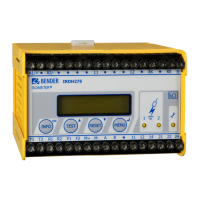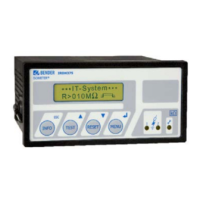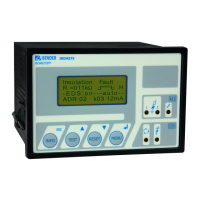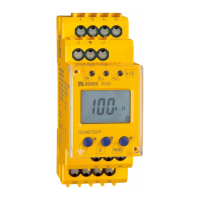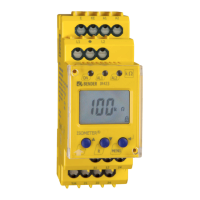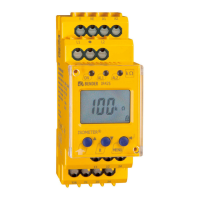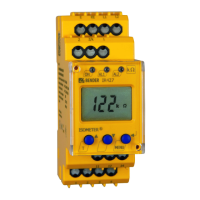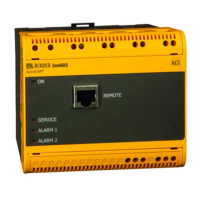Do you have a question about the Bender ISOMETER IRDH275 and is the answer not in the manual?
Provides guidance on manual usage, explains symbols, and their significance.
Details contact information and offered services for commissioning, troubleshooting, repair, and field support.
Information on training programs for test equipment usage and workshop schedules.
Outlines Bender's sale and delivery terms, including software clauses and industry standards.
Procedures for checking packaging, handling transit damage, and proper storage requirements.
Exclusions for warranty and liability claims arising from improper use or unauthorized modifications.
Guidelines for equipment disposal according to WEEE, RoHS directives, and national regulations.
References accompanying safety documentation and general safety principles.
Emphasizes qualified personnel requirement for installation and commissioning to prevent hazards.
Safety notes on unauthorized access, correct voltage, and essential system settings.
Defines the device's primary function: monitoring insulation resistance in IT systems.
Installation guidelines to prevent property damage and ensure correct device connection.
Lists shared features like IT system monitoring, automatic adaptation, and measuring principles.
Highlights specific features of the IRDH275B, such as BMS interface and real-time clock functionality.
Describes the IRDH275 as a versatile device for various AC and DC systems.
Explains the core function of measuring insulation resistance using a pulsating AC voltage.
Details advanced features for IRDH275B, including current output and real-time clock for data logging.
Provides instructions for connecting the device to the power supply, including fuse recommendations.
Illustrates connection methods using various coupling devices like AGH series.
A step-by-step visual guide for the proper commissioning of the ISOMETER®.
Explains the device's front panel controls, LEDs, and display modes.
Guides users through menu navigation, parameter adjustments, and exiting menus.
Details how to manage event logs with date and time stamps in the memory database.
Configuration of basic alarm functions, relay principles, and fault storage behavior.
Settings for advanced functions, including coupling devices, leakage capacitance, and self-test timing.
Configuration of the BMS interface, including bus address and ISOnet communication.
Instructions for activating and setting a password to secure device settings.
Options for selecting the display language for fault messages.
Restricted access for service personnel for fault diagnostics and clearance.
Remote configuration of device parameters using a PC and specific gateway software.
Technical specifications for the RS485 interface using the IsoData protocol for IRDH275.
Technical details for the RS485 interface with BMS protocol for IRDH275B, including network topology.
Correct and incorrect network arrangements and wiring requirements for RS485 communication.
Explains the BMS protocol, Master-Slave operation, and address assignments.
Comprehensive technical specifications presented in tables, including voltage, current, and environmental data.
Lists all relevant industry standards and certifications applicable to the device.
Graphical representations of device performance characteristics under various conditions.
Information required for ordering different device variants, coupling devices, and measuring instruments.
Provides guidance on manual usage, explains symbols, and their significance.
Details contact information and offered services for commissioning, troubleshooting, repair, and field support.
Information on training programs for test equipment usage and workshop schedules.
Outlines Bender's sale and delivery terms, including software clauses and industry standards.
Procedures for checking packaging, handling transit damage, and proper storage requirements.
Exclusions for warranty and liability claims arising from improper use or unauthorized modifications.
Guidelines for equipment disposal according to WEEE, RoHS directives, and national regulations.
References accompanying safety documentation and general safety principles.
Emphasizes qualified personnel requirement for installation and commissioning to prevent hazards.
Safety notes on unauthorized access, correct voltage, and essential system settings.
Defines the device's primary function: monitoring insulation resistance in IT systems.
Installation guidelines to prevent property damage and ensure correct device connection.
Lists shared features like IT system monitoring, automatic adaptation, and measuring principles.
Highlights specific features of the IRDH275B, such as BMS interface and real-time clock functionality.
Describes the IRDH275 as a versatile device for various AC and DC systems.
Explains the core function of measuring insulation resistance using a pulsating AC voltage.
Details advanced features for IRDH275B, including current output and real-time clock for data logging.
Provides instructions for connecting the device to the power supply, including fuse recommendations.
Illustrates connection methods using various coupling devices like AGH series.
A step-by-step visual guide for the proper commissioning of the ISOMETER®.
Explains the device's front panel controls, LEDs, and display modes.
Guides users through menu navigation, parameter adjustments, and exiting menus.
Details how to manage event logs with date and time stamps in the memory database.
Configuration of basic alarm functions, relay principles, and fault storage behavior.
Settings for advanced functions, including coupling devices, leakage capacitance, and self-test timing.
Configuration of the BMS interface, including bus address and ISOnet communication.
Instructions for activating and setting a password to secure device settings.
Options for selecting the display language for fault messages.
Restricted access for service personnel for fault diagnostics and clearance.
Remote configuration of device parameters using a PC and specific gateway software.
Technical specifications for the RS485 interface using the IsoData protocol for IRDH275.
Technical details for the RS485 interface with BMS protocol for IRDH275B, including network topology.
Correct and incorrect network arrangements and wiring requirements for RS485 communication.
Explains the BMS protocol, Master-Slave operation, and address assignments.
Comprehensive technical specifications presented in tables, including voltage, current, and environmental data.
Lists all relevant industry standards and certifications applicable to the device.
Graphical representations of device performance characteristics under various conditions.
Information required for ordering different device variants, coupling devices, and measuring instruments.
| Model | IRD H275 |
|---|---|
| Measurement Accuracy | ±10 % |
| Display | LCD |
| Supply Voltage | 24 V DC / 110-230 V AC |
| Storage Temperature | -40°C to +70°C |
| Power Supply | 24 V DC / 110-230 V AC |
